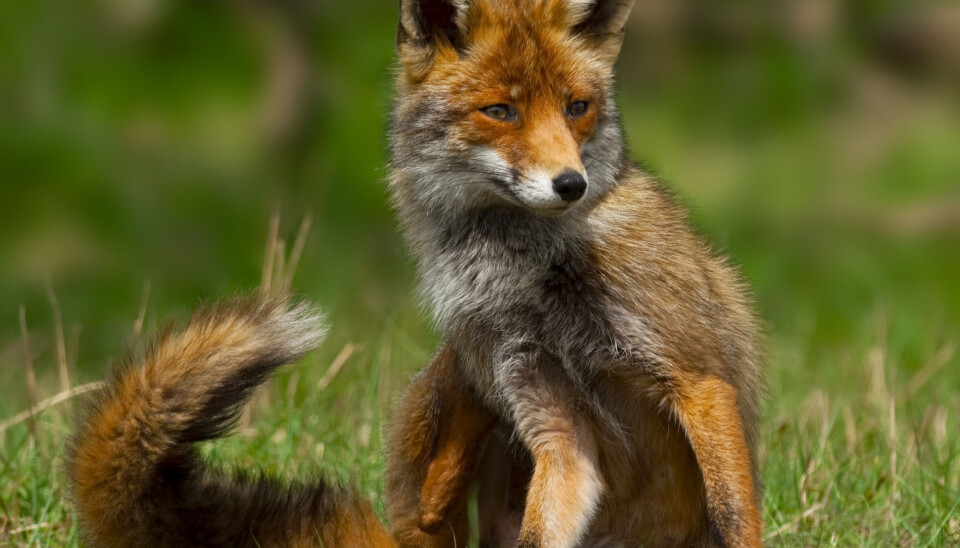
Half of Norwegian red foxes eat rat poison
Many people still put out poison baits, even though this form of rodent control is prohibited.
Traditional rat poison causes small rodents to die from internal bleeding within a few days. The active substances prevent the blood from clotting.
Norway banned the use of rat poison by private individuals in 2014. Yet researchers have found active substances from rodenticides in 54 per cent of the red foxes they examined, according to a recent study.
“We were surprised how many of the foxes had consumed rat poison. The discovery worries us,” says veterinarian and doctoral student Kristin Opdal Seljetun at the Norwegian University of Life Sciences (NMBU).
Foxes may have been poisoned by eating the bait directly or by secondary poisoning through predation.
Foxes ingested bait from several places

Rat poison was found in over half of the 163 fecal samples collected from healthy red foxes shot during hunting season.
Hunters collected the fecal samples for NBMU. The samples were then analysed by the Department of Forensic Medicine at Oslo University Hospital in collaboration with NMBU.
All samples were analysed for the six different active substances used in rat and mouse poison in Norway. Nearly half of the animals that tested positive for the residues had more than one active toxin in their body.
“This is a new method that hasn’t been used before, which specifically reveals which toxins the animal has ingested and in what quantities,” says Seljetun.
Environmental and health problem across Norway
The poison was found in small to moderate amounts in the positive foxes, and she emphasizes that there is little reason to believe they have suffered much.
The samples were obtained from foxes from all the counties in Norway except one. The researchers found no differences between the counties, or from season to season.
However, rat poison can affect fox health, even in small amounts. Experiments on mice have shown that they become less wary when they consume the poison. The toxins can impair their immune system so that they are more susceptible to contracting mange and other parasites and getting itches.
The fertility of poisoned animals can also be affected. Female foxes may have difficulty getting pregnant, can abort more easily or have fewer pups in each litter.
"The red fox findings suggest that this is a major environmental problem among rodent-eating predators in Norway," says Seljetun.
Pest control regulations tightened
Putting out rat poison has been a common method for getting rid of troublesome mice and rats from basements and attics.
Stores have not been allowed to sell bait blocks and grain bait to the general public since their ban in 2014. Now only closed bait boxes for indoor use against mice are available to private individuals.
Pest control professionals and farmers who have received special pest control training are still allowed to use products outdoors and with higher concentrations of the active substances.
In 2017, Norway intensified regulations for private individuals, reducing the amount of the active substance that causes bleeding.
The Norwegian Environment Agency and the EU jointly determined the tightening of the regulations.
Poison builds up over time
The long-term effects on the environment precipitated the banning of the previously used active substances in rat poison.
“The poison doesn’t kill the rodents right away. It can take up to five days before they die. Meanwhile, they may come back to the bait and eat more. Or they may be eaten by larger animals, like birds of prey, cats or foxes in that time,” says Seljetun.
The researchers assume that the foxes got the poison in their system by secondary exposure – that is, they ate animals that had directly consumed the bait. The researchers found up to four different active substances in the same animal.
The active substances take a long time to break down. This means that the fox may have ingested the poison from several animals and over an extended period.
Pets are vulnerable too
“Our findings indicate that the bait ban isn’t common knowledge. It seems a lot of people still use the bait they purchased before the product was withdrawn from the stores,” says Seljetun.
Domestic animals like cats and dogs are also susceptible to rat poison in the same way foxes are.
Given that over half the foxes had toxins in their system, “lynx, wolverine, birds of prey and wolves are similarly vulnerable to the toxins from poisoned rodents,” says Seljetun.
The Norwegian Food Safety Authority is required to regularly check that foxes aren’t carrying small cyclophyllid tapeworms (Echinococcus multilocularis) into Norway. Each year the Authority gives hunters the task of shooting a certain number of red foxes and submitting fecal samples.
Excess material from these fecal samples was used to investigate whether they contained rat poison.
Seljetun believes the Norwegian Environment Agency should be more interested in finding out more about the environmental problem these poisons pose. But so far she hasn’t received the support to do this research.
Seljetun works for the Norwegian Institute of Public Health and NMBU.
------------------------































